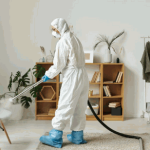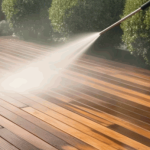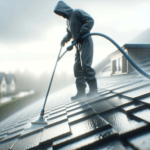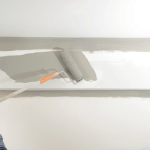Cleaning fireplace brick is essential not only for aesthetic appeal but also for maintaining a safe and functional hearth.
Over time, soot, debris, and stains can accumulate, detracting from the beauty of your fireplace and potentially posing fire hazards. These elements, including ash and dust, can discolored the surface, requiring a thorough cleaning method.
This guide explores the importance of keeping your fireplace brick clean, the tools needed for the job, and step-by-step instructions for both unpainted and painted brick. We’ll also cover cleaning solutions and products like vinegar and baking soda that are essential for effective cleaning.
Additionally, tips for ongoing maintenance will help keep your fireplace looking its best. Utilising expert methods and household items, such as a spray bottle and dish soap, will ensure a gentle DIY approach.
Ready to transform your fireplace using these effective cleaning solutions? Let’s get started!
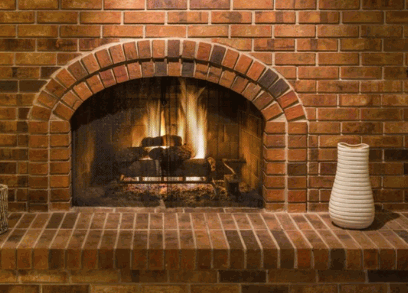
Why Is It Important To Clean Fireplace Brick?
Cleaning the brick fireplace is essential not only for aesthetic reasons but also for safety and efficiency. A build-up of soot, dust, and ash can lead to various issues, such as increased fire hazards and reduced airflow, which can negatively impact the heating capabilities of your fireplace.
Regular cleaning ensures a safe environment by preventing dangerous carbon monoxide build-up, especially if your fireplace is regularly used. Moreover, maintaining the appearance of your brick fireplace enhances the overall aesthetics of your living space, making it a focal point that adds warmth and charm to your home.
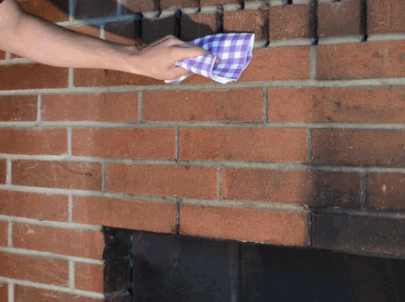
What Tools Do You Need To Clean Fireplace Brick?
To effectively clean your fireplace brick, you will need a variety of tools that allow for thorough cleaning while ensuring safety. Essential tools include a scrub brush and:
- Vacuum cleaner to remove loose dust and soot,
- Soft-bristled brush for gentle scrubbing,
- Sponge for applying cleaning solutions,
- Protective gear such as gloves to keep your hands safe from harsh chemicals, including ammonia and TSP.
Additionally, common household items like vinegar, bicarbonate of soda, and washing-up liquid (also known as dish soap) can serve as effective cleaning solutions for maintaining your brick fireplace’s appearance without damaging the material.
Delve into: Best Way To Clean Laminate Floors
Protective Gear
When cleaning your fireplace bricks, it is crucial to wear appropriate protective gear to ensure safety and avoid skin irritation. Recommended gear includes rubber gloves to protect your hands from harsh cleaning solutions and soot, as well as a dust mask to prevent inhalation of dust particles and harmful chemicals. This safety equipment is essential for maintaining a safe and effective cleaning environment, particularly when using potent cleaning solutions like ammonia or TSP (trisodium phosphate), which are known for their strong cleaning capabilities.
Moreover, protective gear not only safeguards the individual but also enhances the overall cleaning process. For instance, goggles can shield the eyes from splashes of chemicals like borax or debris, while non-slip footwear provides stability on potentially slippery surfaces.
Here are some essential options to consider:
- Rubber gloves: Prevent skin irritation from cleaning agents.
- Dust masks: Essential for filtering out harmful dust and fumes.
- Safety goggles: Protect the eyes from splashes and particulate matter.
- Non-slip footwear: Offers traction on wet surfaces, reducing the risk of falls.
Taking these precautions ensures a safer environment, enables efficient cleaning, and ultimately preserves the integrity of the surfaces being treated.
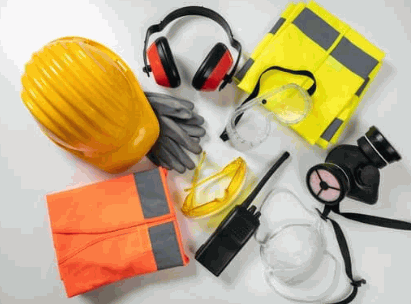
Soft-bristle Brush
A soft-bristle brush is essential for gently scrubbing the surface of your brick fireplace without causing damage. This brush effectively loosens soot, dust, and other debris from the porous surface of the bricks, making it an ideal tool for thorough cleaning. By using a soft-bristle brush, you ensure that the integrity of the brick is maintained while achieving a sparkling finish that enhances your fireplace’s aesthetics.
Utilising this type of brush not only makes the cleaning task more manageable but also significantly reduces the risk of chipping or scratching the brick.
- Soft bristles are particularly effective at reaching into the intricate crevices of the brickwork.
- This type of brush allows homeowners to maintain the original texture and colour of their fireplaces, preserving the charm of the structure.
- Being gentle yet effective, it promotes a gentle DIY cleaning process that any homeowner can master.
This approach enhances not just the appearance but also the longevity of the fireplace, ensuring it remains a cosy focal point in the home for years to come.
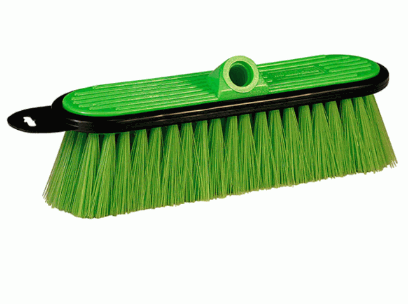
Bucket
A sturdy bucket is essential for mixing your cleaning solution and containing any water used during the cleaning process. Not only does it serve as a central tool for effective cleaning, but it also enhances your efficiency by consolidating your supplies in one manageable location. The bucket can absorb spills, keeping your work area tidy.
When preparing various mixtures, the bucket allows you to blend water with gentle detergents, such as washing up liquid and vinegar, creating a solution that can effectively tackle tough stains and soot. A bucket is invaluable for organising cleaning tools, ensuring that brushes, cloths, and sponges are easily accessible. This organisation facilitates a smoother workflow, making the task less daunting and more productive. Utilise a spray bottle for easy application of your mixture on the bricks.
- Ensure that your bucket is sturdy enough to handle larger volumes of liquid.
- Keep your cleaning tools easily organised within the bucket.
- Experiment with different cleaning mixtures to find what works best for your space.
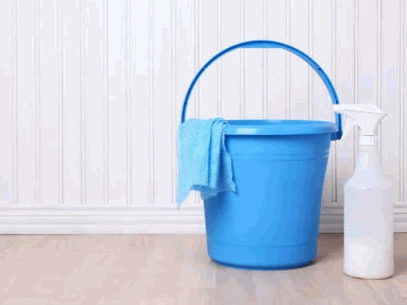
Water
Water is a fundamental component in the cleaning process, serving as a base for your cleaning solutions and helping to loosen stubborn particles and stains from the brick surface. When combined with other household items such as vinegar or bicarbonate of soda, water enhances the effectiveness of your cleaning mixture, allowing for a deep clean without damaging the porous material of the bricks. The correct temperature of water can also play a role in activating these cleaning solutions, making them more effective. Be sure to rinse thoroughly to avoid residue.
In many cases, water acts as a solvent, facilitating the dissolution of dirt and grease, and thereby making it easier to remove these unwanted substances. Whether it’s for an eco-friendly approach using natural cleaners or employing commercial cleaning agents, the interaction of water with these components can significantly improve results. The quality of water used—tap, distilled, or softened—can further influence cleaning effectiveness, impacting how well the solutions work to penetrate and lift grime. Ultimately, the synergy between water and various cleaning agents allows for a more efficient and thorough cleaning experience. This method can be applied to both gas and wood-burning fireplaces.

Mild Detergent
Using a mild detergent, such as washing-up liquid, is vital for effectively cleaning your fireplace bricks without causing harm to the material. This type of cleaner breaks down grease and soot while being gentle enough to preserve the integrity of the bricks. When mixed with water, a mild detergent solution becomes an excellent tool for tackling tough stains and dirt build-up, making your cleaning process more efficient.
Incorporating a mild detergent not only ensures a thorough clean but also significantly reduces the risk of damage to the delicate surfaces of fireplace bricks. To achieve optimal results, one can prepare a solution by mixing two tablespoons of washing-up liquid with approximately a gallon of warm water. This mixture works wonders in lifting embedded grime without scratching or eroding the brick.
- Dampen the bricks with clean water to loosen any stubborn debris.
- Apply the detergent solution using a soft-bristled brush or sponge.
- Rinse everything thoroughly with clean water to remove any soap residue.
With these methods, maintaining your fireplace bricks becomes a breeze, giving them a renewed look while ensuring their longevity.
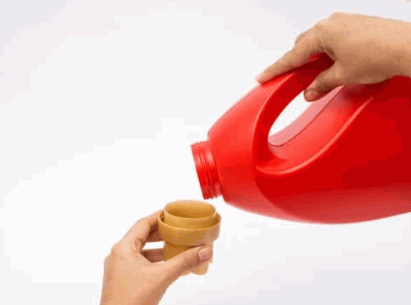
Vinegar
Vinegar is a powerful household item that can be used as an effective cleaning solution for your fireplace brick. Its natural acidity helps to break down tough stains and soot, making it a popular choice for gentle DIY cleaning methods. When mixed with water or bicarbonate of soda, vinegar forms a potent cleaning mixture that cleans the brick without harsh chemicals, ensuring a thorough and safe approach.
Utilising vinegar in your cleaning routine not only enhances the effectiveness of the process but also minimises the exposure to potentially harmful substances. To create a natural cleaning solution, simply combine equal parts of vinegar and water in a spray bottle for everyday stains. For tougher soot build-up, you can sprinkle bicarbonate of soda on the brick first, then spray the vinegar solution, allowing the mixture to fizz and lift away grime.
- Advantages of Vinegar:
- Non-toxic and eco-friendly
- Effective against mould and allergens
- Economical compared to commercial cleaners
- Pleasant smell when diluted
This method not only promotes a healthier living environment but also preserves the integrity of your fireplace brick, ensuring it stays in excellent condition for years to come.
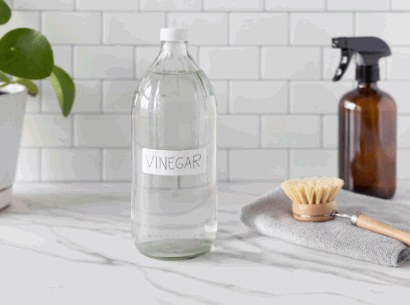
Baking Soda
Bicarbonate of soda is a versatile ingredient that serves as an excellent cleaning solution for your fireplace brick, thanks to its ability to absorb odours and tackle tough stains. When combined with water, vinegar, or washing-up liquid, bicarbonate of soda creates an effective paste that can be applied to discoloured areas of the brick, helping to lift grime and soot for a thorough clean. Its gentle abrasive properties make it safe for use on brick surfaces, ensuring a successful cleaning process. Additionally, you can mix it with cream of tartar for a gentle DIY cleaning solution.
Incorporating bicarbonate of soda into your cleaning routine can significantly enhance the appearance of your fireplace. To begin, prepare a mixture of three parts bicarbonate of soda to one part water to create a thick paste. This combination allows for targeted application on stubborn soot stains. You can also add a bit of TSP (trisodium phosphate) for tougher stains.
- Use a soft-bristled brush to gently scrub the paste into the affected areas.
- Let it sit for at least 15 minutes before rinsing with clean water.
Alternatively, a mix of bicarbonate of soda and vinegar can provide additional fizzing action, further breaking down dirt build-up. This method is effective for those particularly challenging spots, ensuring your brickwork remains pristine with minimal effort.
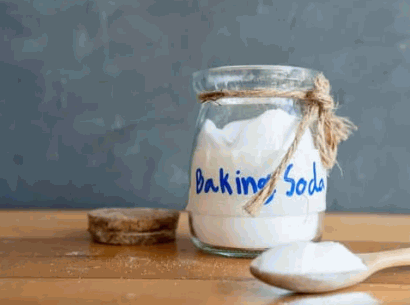
How To Clean Unpainted Brick
Following guidelines from reputable sources like the Better Business Bureau and the Brick Industry Association ensures a safe and effective cleaning process.
According to the Brick Industry Association, cleaning unpainted brick involves specific methods to avoid damage.
Cleaning unpainted brick requires a careful approach to ensure that the material is not damaged while effectively removing soot, ash, and other residues. The process typically starts with preparing the area to protect surrounding surfaces, followed by mixing an appropriate cleaning solution that helps to break down the grime. Using a carbon monoxide detector and a smoke detector is also essential to ensure safety during the cleaning process.
By using gentle scrubbing techniques and thorough rinsing, you can restore the natural beauty of your unpainted brick fireplace, making it a warm and inviting focal point in your home.
Prepare The Area
Preparing the area around your unpainted brick fireplace is a crucial step in the cleaning process to avoid damaging surrounding furniture and surfaces.
To effectively accomplish this, begin by carefully removing decor, furniture, and any personal items from the vicinity to prevent accidental damage during the cleaning. Lay down dust sheets or old towels on the floor to catch any debris and protect your flooring from potential stains.
It’s essential to ensure optimum airflow in the room; opening windows or using fans can significantly enhance ventilation, reducing the chance of inhaling harmful dust and cleaning fumes. This approach not only creates a safer cleaning environment but also safeguards surrounding items from unwanted exposure to cleaning agents.
- Clear the area of any decorative items.
- Cover the floor with protective sheets.
- Increase ventilation by opening windows or turning on fans.
Mix Cleaning Solution
Mixing an effective cleaning solution is essential for achieving optimal results when cleaning unpainted brick. One popular method involves combining equal parts of vinegar and water in a bucket, creating a gentle yet powerful cleaning solution. Alternatively, you can mix bicarbonate of soda with water to form a paste that can be applied directly to stubborn stains, giving you multiple options for tackling the grime on your brick surface. Trisodium phosphate (TSP) is another powerful ingredient that can be added to tough stains.
These solutions not only help maintain the aesthetic appeal of unpainted bricks but also contribute to their longevity by removing harmful buildup.
- To prepare the vinegar solution, simply combine equal parts of plain white vinegar and water in a container. This mixture is effective against dirt and mould.
- For the bicarbonate of soda paste, mix three parts bicarbonate of soda with one part water until you achieve a thick consistency, allowing for precise application.
Once you have your cleaning solutions ready, use a sponge or soft-bristle brush to apply them. Let the mixtures sit for a few minutes to penetrate stains before scrubbing gently—this method ensures deep cleaning without compromising the integrity of the brick.
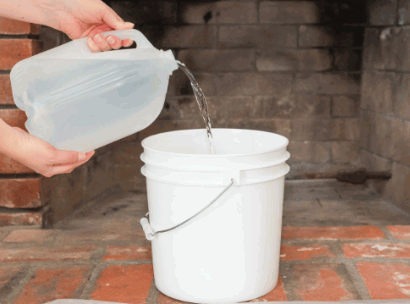
Scrub The Brick
Scrubbing the brick surface is a key step in the cleaning process that requires a gentle touch to avoid damaging the material. While cleaning, keep a carbon monoxide detector and smoke detector active to ensure safety.
To achieve optimal results while caring for the integrity of your brick structure, it is crucial to employ the right techniques and tools. Begin by choosing soft-bristled brushes or specialised scrub brushes that minimise abrasion on the brick. When preparing your cleaning solution, consider using a mild detergent mixed with warm water to effectively break down grime without being harsh. Additionally, using a chimney brush can help reach higher or more recessed areas.
- Start at the top of the brick wall and work your way down
- Use circular motions to gently lift dirt and soot from the surface
- Rinse with clean water after scrubbing to remove any residue
By following these techniques, you not only ensure thorough cleaning but also preserve the natural beauty and texture of the brick.
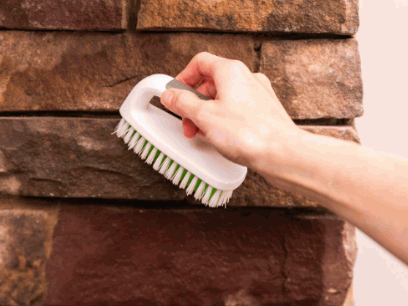
Rinse With Water
Rinsing the brick surface with clean water is a crucial final step in the cleaning process to remove any residual cleaning solution and dirt. This important action ensures that the surface is free from harmful residues that can lead to discolouration and degradation over time. Always ensure proper ventilation using fans or an exhaust system to keep the room safe while rinsing.
Using a clean sponge or cloth dampened with water to wipe down the bricks effectively eliminates any remnants of the cleaning mixture.
This step is essential because it not only prevents potential damage caused by leftover solutions, but also helps to restore the natural appearance of the brick surface. Using a mild detergent recommended by companies can make this step more effective.
Regularly rinsing post-scrub not only keeps the bricks looking their best but also prolongs their longevity. Consulting reliable sources like the Brick Industry Association can provide additional guidance on best practices.
To follow an effective rinsing method, consider these steps:
- Start from the top and work your way down to ensure all residual cleaning products run off.
- Use plenty of clean water to thoroughly rinse any areas that were scrubbed.
- Check for any missed spots to ensure a uniform finish.
Keeping consistent with rinsing preserves the integrity of the brick and keeps your surfaces looking fabulous!
How To Clean Painted Brick
Cleaning painted brick is a different challenge compared to unpainted brick, as highlighted by professionals.
Cleaning painted brick requires a different approach compared to unpainted brick, as the aim is to preserve the paint while effectively removing dirt and soot.
Start by preparing the area and applying a suitable paint stripper to loosen the grime without damaging the underlying paint. This method ensures that you can clean your painted brick fireplace thoroughly and safely, allowing for a fresh and attractive finish. Be cautious about creosote build-up, which might require more intensive cleaning solutions.
Prepare The Area
Preparing the area around your painted brick fireplace is crucial for protecting your home from any damage during the cleaning process. Proper preparation is essential to ensure that your cleaning efforts are effective and that the surrounding environment remains safe and intact.
Begin by carefully removing any decorative items, such as pictures, vases, or seasonal decorations, that could be inadvertently damaged.
- Next, assess the furniture nearby and consider relocating larger pieces that are difficult to cover, if possible.
- For any items that cannot be moved, make sure to wrap them securely with plastic sheeting or old blankets to shield them from potential exposure.
Covering the floor with heavy-duty dust sheets will provide extra protection against spills. Moving on to ventilation, opening all accessible windows and using portable fans not only aids in dispersing unpleasant fumes but also promotes a safer atmosphere during the cleaning phase.
Attention to these details will contribute to a smoother and more effective cleaning process. Always ensure your cleaning methods are recommended by trusted sources like the Better Business Bureau.
Apply Paint Stripper
Applying a paint stripper is a crucial step when cleaning painted brick, as it helps to loosen dirt and soot while preserving the paint underneath. Using a spray bottle, apply the paint stripper evenly across the brick surface, following the manufacturer’s instructions for optimal effectiveness. For best results, use paint strippers recommended by professionals.
Ensure even coverage by starting from the top and working your way down, which helps prevent drips and streaks.
- Before you start, test the stripper on a small, inconspicuous area to check for any adverse reactions.
- Allow it to sit for the recommended time to break down the grime, typically around 15 to 30 minutes.
- Monitor the surface and avoid letting it dry out, as this can hinder the cleaning process.
- If necessary, apply a second coat for tougher stains.
This careful attention to timing and method ensures that you can clean the surface thoroughly without damaging the paint. Always check for certifications and reviews from the Better Business Bureau when hiring professional cleaners to ensure quality service.
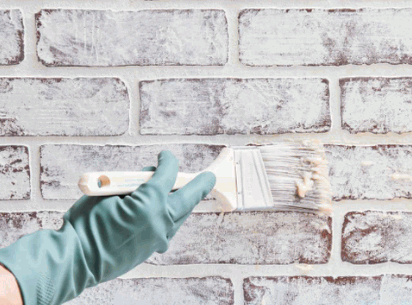
Scrub The Brick
Once the paint stripper has done its job, scrubbing the brick surface is necessary to remove the remaining dirt and stains while ensuring you do not damage the paint. Use a soft-bristle brush or scrubbing brush to gently scrub the surface, taking care to follow the contours of the brick and avoid using excessive force. This method effectively lifts grime while preserving the paint’s finish, leading to a clean and refreshed appearance. Ensuring proper ventilation by using a fan or an exhaust system helps to clear out any chemical fumes during this process.
It’s important to keep the following tips in mind to maintain the integrity of the painted brick. Using tools and cleaning solutions recommended by professionals will ensure a job well done:
- Gentle Pressure: Applying minimal pressure allows the brush to clean without stripping away the paint.
- Water Usage: Lightly dampening the brush can help lift dust and dirt without saturating the brick.
- Regular Maintenance: Frequent gentle cleaning can prevent the buildup of tougher stains and grime, ensuring your brick fireplace looks its best.
By employing these gentle scrubbing techniques, you can ensure that the painted brick remains in pristine condition while achieving a pleasing aesthetic, as recommended by the Brick Industry Association.
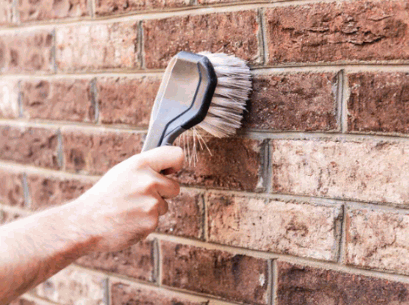
Rinse With Water
Rinsing off the paint stripper and remaining grime with clean water is essential to complete the cleaning process for painted brick. Use a clean sponge or cloth dampened with water to wipe down the brick surface, ensuring that all traces of the paint stripper are removed. This step prevents any residue from affecting the appearance of the paint and ensures your fireplace looks its best.
After applying the paint stripper, proper rinsing becomes crucial in achieving a flawless finish. Begin by using a gentle spray of clean water to saturate the surface, softening any stubborn spots.
Once the area is adequately moistened, use a soft-bristled brush to gently scrub and dislodge remaining residues, paying close attention to corners and crevices. Following this, rinse with large amounts of clean water, which not only aids in removing leftovers but also helps in eliminating any clinging moisture that may attract dirt or mould in the future.
- Remember to change your rinse water frequently for optimal results.
- Ensure that the area is well-ventilated during this process to speed up drying.
- Consider using a final wipe with a clean, dry towel to absorb any lingering water, giving the brick surface a polished look.
Tips For Maintaining A Clean Fireplace Brick
Maintaining clean fireplace brick involves a combination of regular cleaning practices and preventive measures to ensure that soot, dust, and stains do not accumulate over time. Regularly vacuuming the fireplace and wiping down the bricks with a damp cloth can help prevent build-up, while using specialist cleaning solutions when needed can restore the bricks to their original appearance.
By adopting these simple maintenance tips, you can prolong the life of your brick fireplace and keep it looking beautiful.
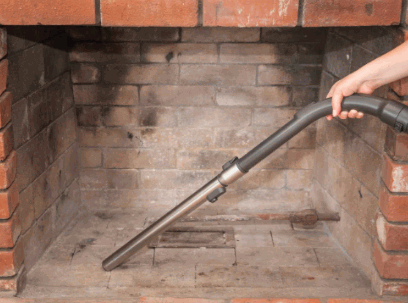
Conclusion
Keeping your fireplace brick clean is essential for both safety and aesthetics, as it enhances the overall beauty of your home and prevents potential hazards associated with soot and build-up.
Maintaining a spotless fireplace is not just about appearance; it plays a crucial role in ensuring a safe and inviting atmosphere. Regular cleaning acts as a protective measure, reducing the risk of fire hazards while preserving the integrity of the brick. Always ensure your smoke detector is functioning properly as an added safety measure.
Homeowners should prioritise understanding various cleaning methods and investing in quality tools to simplify the process, as advised by the Better Business Bureau for optimal household safety and efficiency.
- Start by gathering helpful supplies, such as soft brushes, a vacuum cleaner, and mild cleaning agents.
- Use specific techniques suited for different types of stains, ensuring the longevity of your fireplace.
- A consistent cleaning routine and awareness of proper maintenance practices can transform a standard fireplace into a stunning centrepiece.



